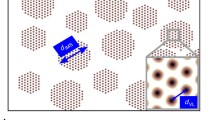Abstract
The Kibble–Zurek (Kibble in J Phys A 9:1387–1398, 1976; Zurek in Nature 317:505–508, 1985) scenario predicts that the outcome of a second-order phase transition from a disordered system into an ordered one depends on the quench rate. The emerging order parameter in the ordered state is not spatially uniform, containing topological defects. The faster the transition, the larger the density of defects. In the case of a conductor–superconductor transition, these defects are flux quanta (vortices). To investigate this scenario, we developed a high-resolution magneto-optical imaging system capable of resolving single flux quanta. Using this system, we imaged arrays of spontaneously created vortices in a Nb film. These vortices were formed after the film was rapidly cooled into the superconducting state at rates around 109 K/s. The internal correlations within the vortex array are important in order to differentiate between competing models. In the Kibble–Zurek scenario, neighboring vortices should have a different polarity, while in Hindmarsh–Rajantie (Hindmarsh and Rajantie in Phys Rev Lett 85:4660–4663, 2000) model the polarity should be the same. Our results favor the Kibble–Zurek scenario.








Similar content being viewed by others
References
T.W.B. Kibble, J. Phys. A 9, 1387–1398 (1976)
W.H. Zurek, Nature 317, 505–508 (1985)
M.B. Hindmarsh, A. Rajantie, Phys. Rev. Lett. 85, 4660–4663 (2000)
A. Rajantie, Phys. Rev. D 79, 043515 (2009)
C. Bauerle, Y.M. Bunkov, S.N. Fisher, H. Godfrin, G.R. Pickett, Nature 382, 332 (1996)
V.H. Ruutu, V.B. Eltsov, A.J. Gill, T.W.B. Kibble, M. Krusius, YuG Marhlin, B. Placais, G. Voloviik, W. Xu, Nature 382, 334 (1996)
R. Carmi, E. Polturak, G. Koren, Phys. Rev. Lett. 84, 4966 (2000)
A. Maniv, E. Polturak, G. Koren, Phys. Rev. Lett. 90, 197001 (2003)
J.R. Kirtley, C.C. Tsuei, F. Tafuri, Phys. Rev. Lett. 91, 257001 (2003)
J.R. Monaco, J. Mygind, R.J. Rivers, V.P. Koshelets, Phys. Rev. B 80, 180501 (2009)
R. Rajarshi, A.M. Srivastava, Phys. Rev. B 68, 174512 (2003)
D. Rugar, H.J. Mamin, P. Guethner, S.E. Lambert, J.E. Stern, I. McFadyen, T. Yogi, J. Appl. Phys. 68, 1169 (1990)
J.R. Kirtley, J. Wikswo, Ann. Rev. Mater. Sci. 29, 117 (1999)
R.P. Hübener, Magnetic Flux Structures in Superconductors (Springer, Berlin, 2001)
P.E. Goa, H. Hauglin, A.F. Olsen, M. Baziljevich, T.H. Johansen, Rev. Sci. Instrum. 74, 141 (2003)
D. Golubchik, E. Polturak, G. Koren, S.G. Lipson, Opt. Express 17, 16160 (2009)
U. Bolz, B. Biehler, D. Schmidt, B. Runge, P. Leiderer, Europhys. Lett. 64, 517 (2003)
D. Golubchik, E. Polturak, G. Koren, Phys. Rev. Lett. 104, 247002 (2010)
D. Golubchik, E. Polturak, G. Koren, Phys. Rev. B85, 060504 (2012). (Rapid Communications)
F. Liu, G.F. Mazenko, Phys. Rev. B 46, 5963 (1992)
D. Golubchik, E. Polturak, G. Koren, B.Y. Shapiro, I. Shapiro, J. Low Temp. Phys. 164, 74 (2011)
A. Rajantie, Contemp. Phys. 44, 485 (2003)
D. Golubchik, Ph.D. Thesis, Technion (2011)
Acknowledgements
I thank my former students Raz Carmi and Ariel Maniv, who initiated our work on this problem. I am grateful to Daniel Golubchik whose talent and hard work made the magneto-optical experiment possible. I thank P. Leiderer for suggesting to us the rapid heating–cooling method. I am indebted to Gad Koren and Steve Lipson for their important contribution to this research. I thank the Editors of JLTP for the opportunity to contribute to the special edition. This work was supported in part by the Israel Science Foundation.
Funding
Funding was provided by Israel Science Foundation (Grant No. 1089/13).
Author information
Authors and Affiliations
Corresponding author
Additional information
Publisher's Note
Springer Nature remains neutral with regard to jurisdictional claims in published maps and institutional affiliations.
Rights and permissions
About this article
Cite this article
Polturak, E. Beyond the Horizon: Magneto-Optical Imaging Studies of the Kibble–Zurek Scenario in Superconductors. J Low Temp Phys 197, 310–320 (2019). https://doi.org/10.1007/s10909-019-02220-8
Received:
Accepted:
Published:
Issue Date:
DOI: https://doi.org/10.1007/s10909-019-02220-8




